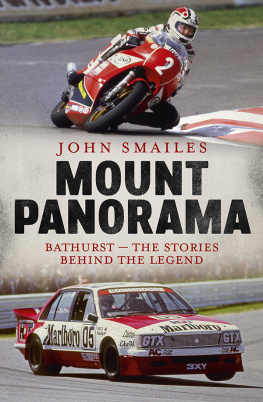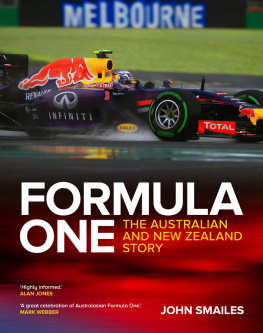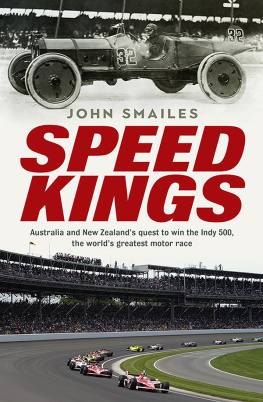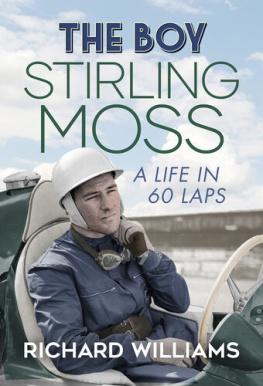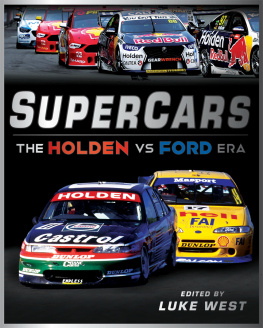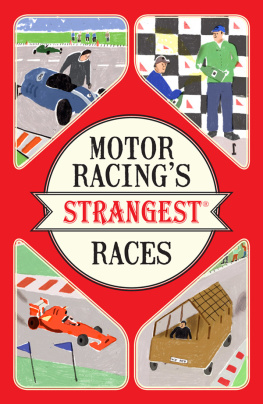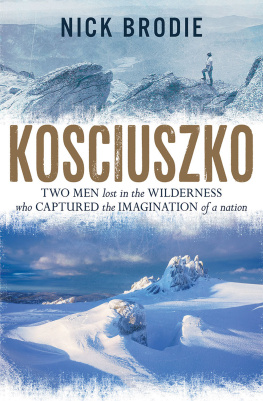JOHN SMAILES is a journalist, motorsport commentator and publicist and until recently proprietor of a specialised communications agency. He co-wrote Climbing the Mountain, the autobiography of Australian motorsport legend Allan Moffat OBE; was the managing editor of the sixtieth anniversary history of the Confederation of Australian Motor Sport; wrote Race Across the World, the incredible story of the 1968 LondonSydney Marathon and a sequel to The Bright Eyes of Danger, written with the first Australian Touring Car Champion David McKay. Mount Panorama has been a big influence in Smailess life. He attended his first-ever motor race at Mount Panorama in 1960where he first met Jack Brabham; raced in two Bathurst 500s; covered car and motorcycle racing as a journalist for print and TV, publicised the motorcycles and was corporate communicator for the cars.
First published in 2019
Copyright John Smailes 2019
All rights reserved. No part of this book may be reproduced or transmitted in any form or by any means, electronic or mechanical, including photocopying, recording or by any information storage and retrieval system, without prior permission in writing from the publisher. The Australian Copyright Act 1968 (the Act) allows a maximum of one chapter or 10 per cent of this book, whichever is the greater, to be photocopied by any educational institution for its educational purposes provided that the educational institution (or body that administers it) has given a remuneration notice to the Copyright Agency (Australia) under the Act.
Allen & Unwin
83 Alexander Street
Crows Nest NSW 2065
Australia
Phone:(61 2) 8425 0100
Email:
Web:www.allenandunwin.com

ISBN 978 1 76052 936 9
eISBN 978 1 76087 249 6
Diagrams by Midland Typesetters, Australia
Index by Puddingburn
Set by Midland Typesetters, Australia
Cover design: Luke Causby / Blue Cork
Cover photographs: Rodger Freeth, The Project Group (front, top);
Peter Brock, Ray Berghouse/Chevron Publishing (front, bottom)
To the founding families:
Arthur OAM and Jan Blizzard
Jack and Tot Hinxman
Ivan and Leonie Stibbard
&
G.T. Jenny

Mount Panorama Circuit

Mount Panorama Elevation
Around the world, enthusiasts refer to it as Mount Panorama, the Mountain or simply Bathurst (Victorians pronounce it as Bath-Hurst: two words), the rural city in the Central West of New South Wales, just over the Great Dividing Range, which is as famed for its motor-racing circuit as Indianapolis is for its speed bowl. There arent too many race circuits named for their city of originor vice versa. In 1911 Indianapolis was built with a surface of 3.2 million paving bricks, and with the goodwill and support of Americas burgeoning motor industry. Mount Panorama was initially made of dirt, built with the hard labour of the otherwise unemployed and under the deep cover of subterfuge.
Mike Kable, an ambitious young reporter for the Lithgow Mercuryhe would soon become one of Australias most revered journalists in the automotive space, the doyen of motoring writersknew he was onto something. Mount Panorama, the countrys pinnacle racetrack, had been built with funds improperly and perhaps illegally obtained from the public purse.
The deception that allowed it to occur involved local government officials, state government ministers and perhaps even a recently deceased prime minister.
It was 1957 and Kable, then 22, had been aware of the story for as long as he could remember. Hed been raised in Bathurst, and as a committed motorsport enthusiast had even been the start-up publicity officer for the Bathurst Light Car Club, formed in 1953 when he was just eighteen.
Mike had served his cadetship on The National Advocate, Bathursts local paper, before being promoted to the Lithgow Mercurypart of a stellar career trajectory that just seven years later would see him anointed as the inaugural motoring editor of Rupert Murdochs flagship national newspaper The Australian. He took motoring journalism out of the car-advice section of the classifieds and elevated it to page-1 prominence. He broke stories of national importance and paved a precipitous path between being a confidante of captains of the industry, and maintaining his objectivity and integrity.
As you probably realise, factual information plays by far the most important part in the compilation of any historical record, he said in a letter to the town clerk of Bathurst City Council when he decided to unlock the secret of Mount Panoramas conception.
It was a time long before the Freedom of Information Act, but Kable had decided, rightly, to formalise his line of enquiry and to hold the Council to account for the actions that had led to the construction of the racetrack that today is regarded as one of the top six road circuits in the world. He wrote his letter on 27 August, and in three days he had his reply.

Bathurst can lay claim to being Australias longest-serving home of consistently top-level motorsport. Initially it was all about motorcycles: as early as 1911, they raced on a street trackthe Peel circuitoutside the satellite suburb of Kelso. In 1914 the first Australian Motorcycle Grand Prix (GP) was held on a 24.8-kilometre triangular course around Kirkconnell, 25 kilometres to Bathursts east. Whether it qualified as the national GP or whether it was the first GP held in Australiaa fine distinctionis lost to history; the city of Goulburn also claims the first Australian GP.
This inaugural Bathurst race was nine laps, making it a phenomenal 223-kilometre distance (even today, grands prix dont run that long), and it took more than three hours for competitors to complete it. Even so, nine of the 27 starters made it to the finish. Brothers Edgar and James Meller took first and fourth places respectively on their matching pair of 2 horsepower Douglas TT bikes. Breakdowns claimed the non-finishers; only one crashed, into a creek, as he traversed Yetholme, Sunny Corner and Meadow Lea.
The following year, on the same dusty, corrugated track, James Meller returned the favour, winning on his Matchless.
They were pioneers. Kirkconnell was a long way from anywhere then and is not much more accessible now, which is why theyve put a gaol there. Seven hundred people turned up to watch that first motorcycle grand prix and it would have been an adventure just getting to the eventespecially if theyd come over the Blue Mountains.
Theres rivalry between cities for big events and the tourist dollars that come with them. Goulburn, proclaimed Australias first inland city in 1863, 22 years before Bathurst, stole the Grand Prix away with the promise of easier access, closer accommodation and a challenging circuit. Goulburn staged the states premier eventsometimes called the Australian Grand Prix or the Australian Tourist Trophy (TT), and other times state-baseduntil 1930. Bathurst was left with speedway racing at the local showground, and it created champions. Local rider Arthur Bluey Wilkinson honed his skills there before going off to race for British club the West Ham Hammers in the Speedway World Championship. He won it in 1938.

